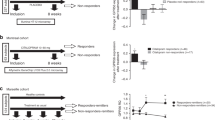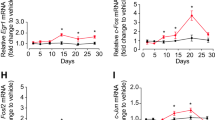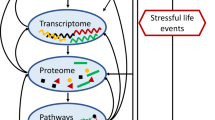Abstract
Studies of the multifunctional protein p11 (also known as S100A10) are shedding light on the molecular and cellular mechanisms underlying depression. Here, we review data implicating p11 in both the amplification of serotonergic signalling and the regulation of gene transcription. We summarize studies demonstrating that levels of p11 are regulated in depression and by antidepressant regimens and, conversely, that p11 regulates depression-like behaviours and/or responses to antidepressants. Current and future studies of p11 may provide a molecular and cellular framework for the development of novel antidepressant therapies.
This is a preview of subscription content, access via your institution
Access options
Subscribe to this journal
Receive 12 print issues and online access
$189.00 per year
only $15.75 per issue
Buy this article
- Purchase on Springer Link
- Instant access to full article PDF
Prices may be subject to local taxes which are calculated during checkout




Similar content being viewed by others
References
Belmaker, R. H. & Agam, G. N. Major depressive disorder. N. Engl. J. Med. 358, 55–68 (2008).
Svenningsson, P. et al. Alterations in 5-HT1B receptor function by p11 in depression-like states. Science 311, 77–80 (2006).
Warner-Schmidt, J. L. et al. Role of p11 in cellular and behavioral effects of 5-HT4 receptor stimulation. J. Neurosci. 29, 1937–1946 (2009).
Marenholz, I., Heizmann, C. W. & Fritz, G. S100 proteins in mouse and man: from evolution to function and pathology (including an update of the nomenclature). Biochem. Biophys. Res. Commun. 322, 1111–1122 (2004).
Gerke, V. & Weber, K. The regulatory chain in the p36-kd substrate complex of viral tyrosine-specific protein kinases is related in sequence to the S-100 protein of glial cells. EMBO J. 4, 2917–2920 (1985).
Svenningsson, P. & Greengard, P. p11 (S100A10) — an inducible adaptor protein that modulates neuronal functions. Curr. Opin. Pharmacol. 7, 27–32 (2007).
Rescher, U. & Gerke, V. S100A10/p11: family, friends and functions. Pflugers Arch. 455, 575–582 (2008).
Warner-Schmidt, J. L. et al. Cholinergic interneurons in the nucleus accumbens regulate depression-like behavior. Proc. Natl Acad. Sci. USA 109, 11360–11365 (2012).
Egeland, M., Warner-Schmidt, J., Greengard, P. & Svenningsson, P. Co-expression of serotonin 5-HT1B and 5-HT4 receptors in p11 containing cells in cerebral cortex, hippocampus, caudate-putamen and cerebellum. Neuropharmacology 61, 442–450 (2011).
Schmidt, E. F. et al. Identification of the cortical neurons that mediate antidepressant responses. Cell 149, 1152–1163 (2012).
Oh, Y. S. et al. SMARCA3, a chromatin remodeling factor, is required for p11-dependent antidepressant action. Cell 152, 831–843 (2013).
Alexander, B. et al. Reversal of depressed behaviors in mice by p11 gene therapy in the nucleus accumbens. Sci. Transl. Med. 2, 54ra76 (2010).
Anisman, H. et al. Serotonin receptor subtype and p11 mRNA expression in stress-relevant brain regions of suicide and control subjects. J. Psychiatry Neurosci. 33, 131–141 (2008).
Warner-Schmidt, J. L. et al. A role for p11 in the antidepressant action of brain-derived neurotrophic factor. Biol. Psychiatry 68, 528–535 (2010).
Zhang, X., Andren, P. E., Greengard, P. & Svenningsson, P. Evidence for a role of the 5-HT1B receptor and its adaptor protein, 11, in L-DOPA treatment of an animal model of Parkinsonism. Proc. Natl Acad. Sci. USA 105, 2163–2168 (2008).
Saarelainen, T. et al. Activation of the TrkB neurotrophin receptor is induced by antidepressant drugs and is required for antidepressant-induced behavioral effects. J. Neurosci. 23, 349–357 (2003).
Okuse, K. et al. Annexin II light chain regulates sensory neuron-specific sodium channel expression. Nature 417, 653–656 (2002).
Masiakowski, P. & Shooter, E. M. Nerve growth factor induces the genes for two proteins related to a family of calcium-binding proteins in PC12 cells. Proc. Natl Acad. Sci. USA 85, 1277–1281 (1988).
Warner-Schmidt, J. L. et al. Antidepressant effects of selective serotonin reuptake inhibitors (SSRIs) are attenuated by antiinflammatory drugs in mice and humans. Proc. Natl Acad. Sci. USA 108, 9262–9267 (2011).
Anisman, H., Gibb, J. & Hayley, S. Influence of continuous infusion of interleukin-1β on depression-related processes in mice: corticosterone, circulating cytokines, brain monoamines, and cytokine mRNA expression. Psychopharmacology 199, 231–244 (2008).
Raison, C. L. & Miller, A. H. Is depression an inflammatory disorder? Curr. Psychiatry Rep. 13, 467–475 (2011).
Song, C., Zhang, Y. & Dong, Y. Acute and subacute IL-1β administrations differentially modulate neuroimmune and neurotrophic systems: possible implications for neuroprotection and neurodegeneration. J. Neuroinflammation 10, 59–74 (2013).
Müller, N. et al. The cyclooxygenase-2 inhibitor celecoxib has therapeutic effects in major depression: results of a double-blind, randomized, placebo controlled, add-on pilot study to reboxetine. Mol. Psychiatry 11, 680–684 (2006).
Trivedi, M. H. et al. Non-steroidal anti-inflammatory drug use is associated with lower remission rate with escitalopram but not with other antidepressants. Neuropsychopharmacology 38, S314–S446 (2012).
Zhang, L. et al. p11 is up-regulated in the forebrain of stressed rats by glucocorticoid acting via two specific glucocorticoid response elements in the p11 promoter. Neuroscience 153, 1126–1134 (2008).
Eriksson, T. M. et al. Bidirectional regulation of emotional memory by 5-HT1B receptors involves hippocampal p11. Mol. Psychiatry http://dx.doi.org/10.1038/mp.2012.130 (2012).
Egeland, M., Warner-Schmidt, J., Greengard, P. & Svenningsson, P. Neurogenic effects of fluoxetine are attenuated in p11 (S100A10) knockout mice. Biol. Psychiatry 67, 1048–1056 (2010).
Réty, S. et al. The crystal structure of a complex of p11 with the annexin II N-terminal peptide. Nature Struct. Biol. 6, 89–95 (1999).
Gerke, V., Creutz, C. E. & Moss, S. E. Annexins: linking Ca2+ signalling to membrane dynamics. Nature Rev. Mol. Cell Biol. 6, 449–461 (2005).
Gerfen, C. R. & Surmeier, D. J. Modulation of striatal projection systems by dopamine. Annu. Rev. Neurosci. 34, 441–466 (2011).
O'Neill, M. F. & Conway, M. W. Role of 5-HT1A and 5-HT1B receptors in the mediation of behavior in the forced swim test in mice. Neuropsychopharmacology 24, 391–398 (2001).
Lucas, G. et al. Serotonin4 (5-HT4) receptor agonists are putative antidepressants with a rapid onset of action. Neuron 55, 712–725 (2007).
Svenningsson, P. et al. Biochemical and behavioral evidence for antidepressant-like effects of 5-HT6 receptor stimulation. J. Neurosci. 27, 4201–4209 (2007).
Debauve, G., Capouillez, A., Belayew, A. & Saussez, S. The helicase-like transcription factor and its implication in cancer progression. Cell. Mol. Life Sci. 65, 591–604 (2008).
Zaidi, S. K. et al. Nuclear microenvironments in biological control and cancer. Nature Rev. Cancer 7, 454–463 (2007).
Liu, J. et al. Nuclear annexin II negatively regulates growth of LNCaP cells and substitution of ser 11 and 25 to glu prevents nucleo-cytoplasmic shuttling of annexin II. BMC Biochem. 4, 10–25 (2003).
Vishwanatha, J. K., Jindal, H. K. & Davis, R. G. The role of primer recognition proteins in DNA replication: association with nuclear matrix in HeLa cells. J. Cell. Sci. 101, 25–34 (1992).
Barlow, C. A., Laishram, R. S. & Anderson, R. A. Nuclear phosphoinositides: a signaling enigma wrapped in a compartmental conundrum. Trends Cell. Biol. 20, 25–35 (2010).
Hargreaves, D. C. & Crabtree, G. R. ATP-dependent chromatin remodeling: genetics, genomics and mechanisms. Cell Res. 21, 396–420 (2011).
Sheridan, P. L., Schorpp, M., Voz, M. L. & Jones, K. A. Cloning of an SNF2/SWI2-related protein that binds specifically to the SPH motifs of the SV40 enhancer and to the HIV-1 promoter. J. Biol. Chem. 270, 4575–4587 (1995).
Altman, J. & Das, G. D. Autoradiographic and histological evidence of postnatal hippocampal neurogenesis in rats. J. Comp. Neurol. 124, 319–335 (1965).
Eriksson, P. S. et al. Neurogenesis in the adult human hippocampus. Nature Med. 4, 1313–1317 (1998).
Malberg, J. E., Eisch, A. J., Nestler, E. J. & Duman, R. S. Chronic antidepressant treatment increases neurogenesis in adult rat hippocampus. J. Neurosci. 20, 9104–9110 (2000).
Santarelli, L. et al. Requirement of hippocampal neurogenesis for the behavioral effects of antidepressants. Science 301, 805–809 (2003).
Holtzheimer, P. E. & Mayberg, H. S. Deep brain stimulation for psychiatric disorders. Annu. Rev. Neurosci. 34, 289–307 (2011).
Sanacora, G., Zarate, C. A., Krystal, J. H. & Manji, H. K. Targeting the glutamatergic system to develop novel, improved therapeutics for mood disorders. Nature Rev. Drug Discov. 7, 426–437 (2008).
Tzang, R. F. et al. Association study of p11 gene with major depressive disorder, suicidal behaviors and treatment response. Neurosci. Lett. 447, 92–95 (2008).
Perlis, R. H. et al. Pharmacogenetic analysis of genes implicated in rodent models of antidepressant response: association of TREK1 and treatment resistance in the STAR*D study. Neuropsychopharmacology 33, 2810–2819 (2008).
Ripke, S. et al. A mega-analysis of genome-wide association studies for major depressive disorder. Mol. Psychiatry 18, 497–511 (2013).
Acknowledgements
We acknowledge the important contributions of N. Heintz, E. Schmidt, D. Patel, P. Gao and M. Kaplitt to our understanding of the various functions of p11. This work was supported by the Fisher Center for Alzheimer's Research Foundation (P.S. and P.G.), W81XWH-09-1-0402 (P.G.), NIH MH090963 (P.G.), NIDA1RC2DA028968 (P.G.), The JPB Foundation (P.G.), W81XWH-09-1-0392 (Y.K.), W81XWH-09-1-0401 (J.L.W.-S.), and Swedish Research Council (P.S.). We apologize to the authors of the many interesting studies that could not be included owing to space constraints.
Author information
Authors and Affiliations
Corresponding author
Ethics declarations
Competing interests
The authors declare no competing financial interests.
Rights and permissions
About this article
Cite this article
Svenningsson, P., Kim, Y., Warner-Schmidt, J. et al. p11 and its role in depression and therapeutic responses to antidepressants. Nat Rev Neurosci 14, 673–680 (2013). https://doi.org/10.1038/nrn3564
Published:
Issue Date:
DOI: https://doi.org/10.1038/nrn3564
This article is cited by
-
Reduction of p11 in dorsal raphe nucleus serotonergic neurons mediates depression-like behaviors
Translational Psychiatry (2023)
-
LD block disorder-specific pleiotropic roles of novel CRHR1 in type 2 diabetes and depression disorder comorbidity
European Archives of Psychiatry and Clinical Neuroscience (2023)
-
Role of P11 through serotonergic and glutamatergic pathways in LID
Molecular Biology Reports (2023)
-
Impaired migratory phenotype of CD4+ T cells in Parkinson’s disease
npj Parkinson's Disease (2022)
-
Ependymal cells-CSF flow regulates stress-induced depression
Molecular Psychiatry (2021)



